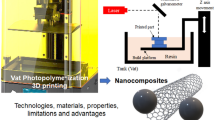Abstract
In this work, a customized 3D ceramic printer was successfully designed and constructed. Three ceramic materials, alumina, Bioglass 45S5 (Bioglass), and zirconia were 3D printed into a C-ring shape by extruding the ceramic slurries. Once the 3D-printed specimens were in green state, a sintering process was performed. The microhardness values of the 3D-printed ceramic specimens were measured using a Vickers hardness tester. The hardness of the specimens increased from 37 ± 3 to 112 ± 5 HV0.2 for alumina, 23 ± 5 to 35 ± 1 HV0.2 for Bioglass, and 22 ± 5 to 31 ± 3 HV0.2 for zirconia, before and after the sintering process, respectively. These results, synthesis of slurries, the formation of specimens, and the mechanical properties, demonstrate the feasibility of 3D printing ceramic materials using a customized 3D ceramic printer.






Similar content being viewed by others
References
Doreau F, Chaput C, Chartier T (2000) Stereolithography for manufacturing ceramic parts. Adv Eng Mater 2:493–496
Derby B (2011) Inkjet printing ceramics: from drops to solid. J Eur Ceram Soc 31:2543–2550
Kruth JP, Mercelis P, Van Vaerenbergh J, Froyen L, Rombouts M (2005) Binding mechanisms in selective laser sintering and selective laser melting. Rapid Prototyp J 11:26–36
Wikes J, Hagedom YC, Meiners W, Wissenbach K (2013) Additive manufacturing of ZrO2–Al2O3 ceramic components by selective laser melting. Rapid Prototyp J 19:51–57
Travitzky N, Bonet A, Dermeik B, Fey T, Filbert-Demut I, Schlier L et al (2014) Additive manufacturing of ceramic-based materials. Adv Eng Mater 16:729–754
Dehurtevent M, Robberecht L, Hornez J-C, Thuault A, Deveaux E, Béhin P (2017) Stereolithography: a new method for processing dental ceramics by additive computer-aided manufacturing. Dent Mater 33:477–485
Slots C, Jensen MB, Ditzel N, Hedegaard MAB, Borg SW, Albrektsen O et al (2017) Simple additive manufacturing of an osteoconductive ceramic using suspension melt extrusion. Dent Mater 33:198–208
Curodeau E, Sachs, Caldarise S (2000) Design and fabrication of cast orthopedic implants with freeform surface textures from 3-D printed ceramic shell. J Biomed Mater Res 53:525–535
Wu Y, Luo G, Cuniberti Y, Xiao, Gelinsky M (2011) Three-dimensional printing of hierarchical and tough mesoporous bioactive glass scaffolds with a controllable pore architecture, excellent mechanical strength and mineralization ability. Acta Biomater 7:2644–2650
Chen QZ, Thompson ID, Boccaccini AR (2006) 45S5 Bioglass®-derived glass–ceramic scaffolds for bone tissue engineering. Biomaterials 27:2414–2425
Wiesner VL, Youngblood JP, Trice RW (2014) “Room-temperature injection molding of aqueous alumina-polyvinylpyrrolidone suspensions”. J Eur Ceram Soc 34:453–463
Rueschhoff L et al (2016) Additive manufacturing of dense ceramic parts via direct ink writing of aqueous alumina suspensions. Int J Appl Ceram Technol 13.5:821–830
Stawarczyk B et al (2013) “The effect of zirconia sintering temperature on flexural strength, grain size, and contrast ratio. Clin Oral Investig 17(1):269–274
Ersoy N, Murat et al (2015) The effects of sintering temperature and duration on the flexural strength and grain size of zirconia. Acta Biomaterialia Odontologica Scandinavica 1.2–4:43–50.
Acknowledgements
The study is supported by the Multidisciplinary Undergraduate Research Institute (MURI) at Indiana University–Purdue University Indianapolis (Director: Dr. Dominique Galli). Jing Zhang and Yeon-Gil Jung acknowledge the additional financial supports provided by the research project entitled “Development of ceramic core for fabricating 450 mm impeller with flow thickness of 4 mm based on 3D printing technology, and its commercialization technology” funded by Jin Sung Precision Metal Co., Ltd., Republic of Korea. Yeon-Gil Jung and Jing Zhang acknowledge the additional financial supports provided by the Korea Institute of Energy Technology Evaluation and Planning (KETEP) and the Ministry of Trade, Industry & Energy (MOTIE) of the Republic of Korea (No. 20172020108530), and by “Human Resources Program in Energy Technology” of the KETEP and MOTIE of the Republic of Korea (No. 20174030201460). The authors would like to thank Krystiana Kosobucki for editing. The authors would also like to thank Professor Rodney Trice and Dr. Valerie Lynn Wiesner at Purdue University for their valuable guidance in preparing the alumina slurry.
Author information
Authors and Affiliations
Corresponding authors
Ethics declarations
Conflict of interest
On behalf of all authors, the corresponding author states that there is no conflict of interest.
Rights and permissions
About this article
Cite this article
Owen, D., Hickey, J., Cusson, A. et al. 3D printing of ceramic components using a customized 3D ceramic printer. Prog Addit Manuf 3, 3–9 (2018). https://doi.org/10.1007/s40964-018-0037-3
Received:
Accepted:
Published:
Issue Date:
DOI: https://doi.org/10.1007/s40964-018-0037-3




